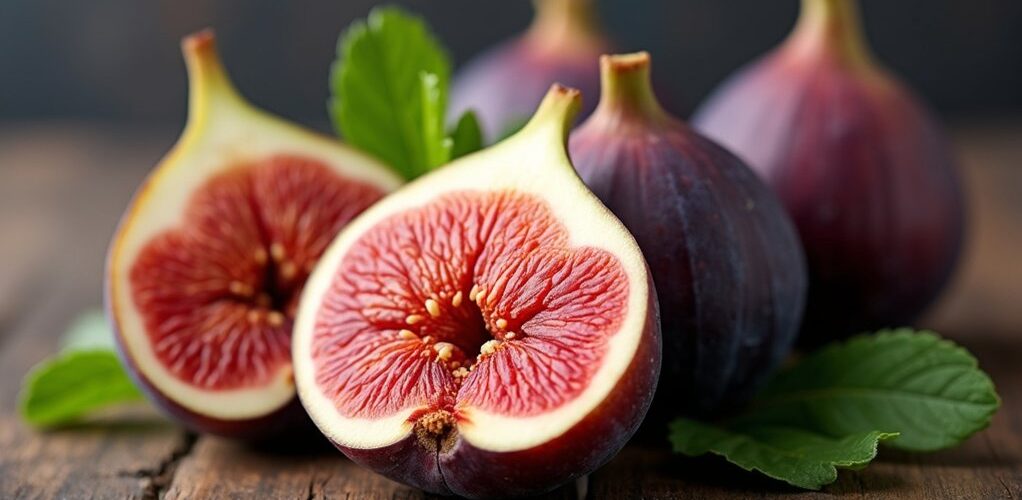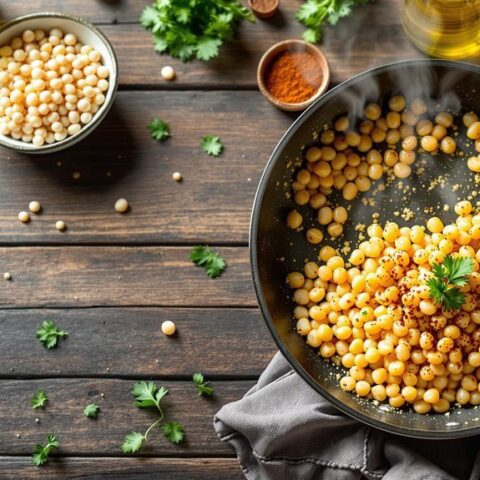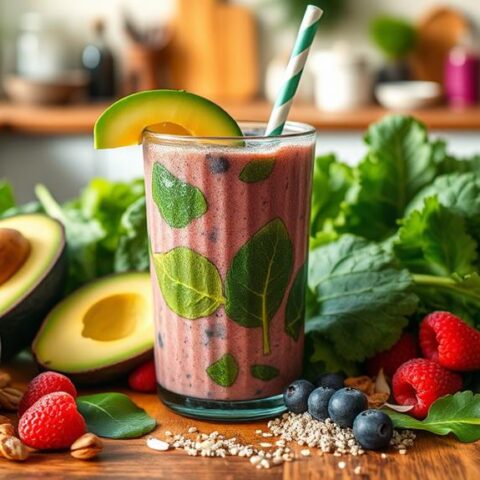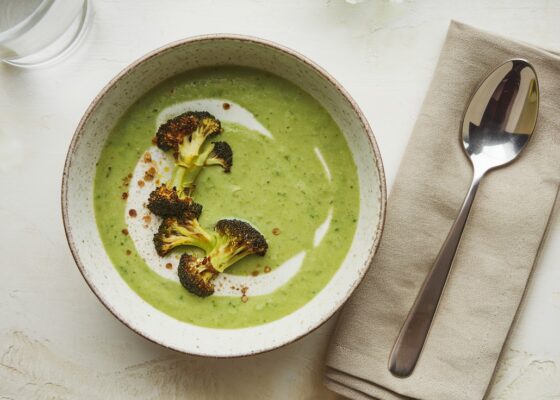
Figs are not considered a low-carb fruit, containing approximately 19.18 grams of carbohydrates per 100-gram serving. Fresh figs have about 8 grams of carbs per medium fruit, while dried figs contain even higher concentrations of sugar. Despite their carb content, figs offer significant nutritional benefits, including fiber, vitamins, and minerals. For those following low-carb diets, portion control is essential, with recommended servings limited to one small fig. Understanding fig varieties and preparation methods can help incorporate this nutrient-rich fruit into various dietary approaches.
Key Takeaways
- Figs are not considered low-carb, containing approximately 19.18g of carbohydrates per 100g serving of fresh figs.
- Fresh figs contain 8g of carbohydrates per medium fig, while dried figs have triple the sugar content.
- Net carbs in fresh figs are 16.28g per 100g after subtracting fiber content of 2.9g.
- Portion control is essential; limit consumption to one small fig (40g) per serving for carb management.
- Fresh figs are a better choice than dried figs for lower carb intake, containing 6.5g sugar per 100g.
Understanding Fig's Carbohydrate Profile
Understanding the carbohydrate content of figs is essential for anyone monitoring their daily carb intake or following specific dietary requirements.
Fresh figs contain approximately 19.18g of carbohydrates per 100g serving, with 16.28g of net carbs after subtracting fiber content. For those following a low-carb diet, these numbers present a significant challenge when managing net carbs per day.
Fresh figs pack over 16 grams of net carbs per serving, making them a challenging choice for low-carb dieters.
While fresh figs are high in natural sugar, dried figs contain even more concentrated sugars, with approximately 20g per 40g serving. This makes both varieties challenging to incorporate into restricted-carbohydrate meal plans.
For individuals seeking low sugar fruits, alternatives like berries and avocados offer substantially lower carbohydrate profiles, making them more suitable choices for those limiting their carb consumption.
Net Carbs Vs Total Carbs in Figs
When examining figs' carbohydrate content, understanding the distinction between total and net carbs proves essential for accurate dietary tracking.
Total carbohydrates in figs include all sugars and fiber content, while net carbs represent the total carbohydrates minus the dietary fiber, which has minimal impact on blood sugar levels.
Fresh figs contain 19.18 grams of total carbohydrates per 100 grams, with 2.9 grams of fiber, resulting in 16.28 grams of net carbs that directly affect blood sugar and should be carefully monitored by those following carb-restricted diets.
Understanding Carb Calculation Methods
The calculation of carbohydrates in figs requires distinguishing between total carbs and net carbs, which serves as vital knowledge for dietary planning.
In fresh figs, the total carbohydrate content of 19.18g per 100g includes both digestible and non-digestible components, while net carbs amount to 16.28g after subtracting fiber content. This distinction becomes particularly important for those following a ketogenic diet or low carb lifestyle.
For accurate carb counting, it's important to note that dried figs are markedly higher in sugar concentration compared to fresh ones, making them less suitable for carb-restricted diets.
Understanding these calculation methods helps individuals make informed decisions about incorporating figs into their meal plans while maintaining their dietary goals.
Total Versus Net Explained
A clear distinction between total and net carbs in figs reveals vital information for dietary planning and nutritional tracking. The fiber content plays a significant role in determining the actual impact on blood sugar levels, particularly for those following a low-carb eating plan. While figs are high in carbohydrates, understanding the difference between their total carbohydrates and net carbs helps make informed dietary choices.
| Measurement | Total Carbs | Net Carbs |
|---|---|---|
| Per 100g | 19.18g | 16.28g |
| Per Fig | 8g | 6.5g |
| Daily %* | 6.4% | 5.4% |
| Fiber Impact | -2.9g | Subtracted |
| Diet Type | All Diets | Low-Carb |
*Based on 300g daily carb intake
Fresh Vs Dried Figs: a Sugar Comparison
Understanding sugar content differences between fresh and dried figs reveals significant nutritional variations that impact dietary choices. Fresh figs contain approximately 6.5 grams of sugar and 7.7 grams of carbohydrates per 100 grams, making them a moderate option for health-conscious individuals. Their fiber content of 1.2 grams per fig helps regulate blood sugar absorption.
In contrast, dried figs pack a much higher sugar concentration, containing around 20 grams of sugar per 40-gram serving. The dehydration process concentrates the natural sugars, resulting in dried figs having up to three times more sugar than their fresh counterparts.
This substantial difference in carbohydrate content makes dried figs less suitable for low-carb diets, while fresh figs can be enjoyed more liberally when monitoring sugar intake.
Health Benefits Beyond the Carb Count
While carbohydrate content remains an important consideration when consuming figs, these remarkable fruits offer numerous health benefits that extend far beyond their sugar levels.
Despite being low in calories, figs are high in dietary fiber, which promotes digestive health and helps regulate bowel movements. The fruits are packed with essential vitamins and minerals, including potassium, magnesium, and calcium, which contribute to heart health and overall well-being.
Additionally, figs contain antioxidants and phytochemicals that provide anti-inflammatory benefits, while their natural compounds support improved blood sugar management through enhanced insulin sensitivity.
The potassium content in figs also plays a significant role in maintaining healthy blood pressure levels, making them a valuable addition to a balanced diet.
Impact on Blood Sugar and Ketosis
Despite their numerous health benefits, figs present significant challenges for individuals monitoring their blood sugar levels or following ketogenic diets.
With approximately 16.28g of net carbs per 100g, figs are not among the fruits lowest in sugar, making it difficult to maintain ketosis while consuming them. Their high in natural sugars content, particularly when dried, can cause substantial impact on blood sugar levels, potentially disrupting blood glucose management.
For those following a ketogenic diet with strict carb intake limitations of 20-50 grams daily, even small servings of figs can quickly consume a significant portion of their allowance. The reduction in HbA1c levels by approximately 1.02% observed in those adhering to a ketogenic diet highlights the importance of careful carb management for effective blood sugar control.
While figs contain fiber that somewhat moderates their glycemic impact, careful portion control remains essential for anyone seeking to maintain ketosis or manage blood sugar effectively.
Portion Control Guidelines for Fig Consumption
Careful measurement of fresh fig portions is essential for maintaining ketosis, with experts recommending limiting intake to one small fig (40g) per serving to manage carbohydrate consumption effectively.
When planning daily carb budgets, individuals should account for the 8g of carbohydrates in each small fig, ensuring this amount fits within their overall carb allowance while leaving room for other nutritional needs.
Measuring Fresh Fig Servings
Understanding portion sizes for fresh figs plays an important role in managing carbohydrate intake effectively. A single small fig contains approximately 6.5 grams of natural sugar and 8 grams of carbohydrates, making precise measurement essential for those following a low-carb diet. For individuals strictly monitoring their daily carb limit, consuming one small fig per day is recommended.
To accurately track consumption, it's helpful to note that a medium fresh fig weighs about 40 grams, with carbohydrate content calculated at 19.18 grams per 100 grams.
Using food tracking apps or diaries can assist in managing portion control effectively. Those seeking to incorporate figs while maintaining carbohydrate restrictions should consider pairing them with low-carb foods to balance their overall intake.
Daily Carb Budget Planning
Managing a daily carbohydrate budget requires astute attention to fig portions, especially given their concentrated sugar content. With approximately 16.28g of net carbs per 100g, figs can quickly consume a significant portion of a low-carb dieter's daily allowance.
For those following strict carbohydrate restrictions, even one small fresh fig contains enough natural sugars to impact their daily limits substantially.
To effectively incorporate figs while maintaining carb goals, careful portion control and moderation are essential. Consider limiting consumption to half a fresh fig, particularly when following a low-carb eating plan that restricts daily intake to 20-50g of net carbs.
Alternatively, substituting figs with lower-carb fruits like berries can provide greater flexibility within established carbohydrate parameters while still satisfying sweet cravings.
Small Portions Stay Keto
Portion control plays a pivotal role in maintaining ketosis while enjoying figs, as even small amounts can greatly impact daily carbohydrate limits.
When following a keto diet, consuming one small fresh fruit fig (approximately 40 grams) provides about 8 grams of carbohydrates and 6.5 grams of natural sugar, making precise measurement essential for staying within low carb parameters.
While fresh figs can be incorporated into a keto diet in controlled amounts, dried figs should be approached with extreme caution due to their concentrated sugar content.
To effectively manage fig consumption, individuals should track their intake using food diaries or monitoring apps, ensuring small portions align with their daily carbohydrate allowance.
This careful approach allows for occasional enjoyment of this sweet fruit while maintaining ketosis.
Low-Carb Fruit Alternatives to Figs
While figs offer unique flavors and textures, several low-carb fruits provide excellent alternatives for those watching their carbohydrate intake. Berries stand out as particularly suitable options, with raspberries and blackberries containing just 5.5g and 4.3g of net carbs per 100g respectively. Avocados emerge as an especially low-carb choice, featuring only 1.8g of net carbs per 100g, while citrus fruits like lemons and limes contribute bright flavors with approximately 5g of net carbs per fruit. For those seeking exotic alternatives, starfruit presents an attractive option with merely 3.5g of net carbs per fruit. Unsweetened acai puree proves particularly versatile in smoothies and bowls, containing just 1g of net carbs per 100g, making it an ideal base for low-carb fruit preparations. Additionally, dark chocolate can be a keto-friendly treat when chosen with 70% cocoa or higher, offering antioxidants that benefit heart health.
Creative Ways to Fit Figs Into a Low-Carb Diet
Despite their higher carbohydrate content, fresh figs can be thoughtfully incorporated into a low-carb eating plan through careful portion control and strategic preparation methods.
Health-conscious individuals can experiment with fig-infused alternatives, such as sugar-free fig-flavored beverages or small amounts of fig essence in recipes, to capture the distinctive taste without excessive carbs.
Smart preparation techniques, including pairing figs with high-fat ingredients or using them as minimal garnishes, allow for the enjoyment of this fruit while maintaining adherence to low-carb dietary goals.
Mindful Fig Portion Control
Savvy fig enthusiasts following a low-carb lifestyle can still enjoy these sweet treats through mindful portion control and creative serving strategies. Understanding that a small fresh fig contains approximately 7.7g of carbs and 6.5g of sugar, individuals can make informed decisions about incorporating these fruits into their low-carb diet.
To maximize enjoyment while managing carb intake, pairing figs with high-fat foods like cheese or nuts creates a satisfying experience that aligns with dietary goals.
Using figs as garnishes or incorporating them into salads provides creative culinary uses without overwhelming daily carb limits. Tracking consumption through food diaries or apps helps guarantee portion control remains consistent with personal nutritional targets, allowing fig lovers to savor these sweet fruits while maintaining their low-carb lifestyle.
Keto-Friendly Fig Alternatives
Several creative alternatives and preparation methods allow keto dieters to enjoy the essence of figs while maintaining their low-carb lifestyle.
For those following a keto meal plan, substituting figs with low carb fruits like berries offers similar satisfaction with considerably fewer carbohydrates. When incorporating fresh figs, combining small portions with leafy greens and keto-friendly dressing creates a balanced salad that stays within carb limits.
Creative options include fig-infused water, which provides flavor without carbs, and using mashed figs as a natural sweetener in keto-friendly baked goods made with almond or coconut flour.
For a unique approach, fig leaves can be used to wrap protein-rich foods, adding distinctive flavor while keeping meals low in carbohydrates, making them suitable for ketogenic dietary requirements.
Savvy Fig Prep Tips
While fresh figs contain natural sugars and carbohydrates, mindful preparation techniques enable low-carb dieters to incorporate these sweet fruits into their meal plans.
For healthy recipes that maintain carb consciousness, consider grilling fresh figs to enhance their natural sweetness while serving them alongside protein-rich foods. Creating invigorating fig-infused water offers a flavorful hydration option without the carbs typically found in whole figs, which are naturally high in sugar.
When developing preparation tips for low-carb diet adherence, focus on using fresh figs in salad combinations with leafy greens and nuts, allowing for controlled portions while maximizing flavor impact.
Remember to choose fresh over dried varieties, as dried figs contain considerably more concentrated sugars and carbs per serving.
Nutritional Value of Different Fig Varieties
Different varieties of figs present distinct nutritional profiles, with fresh and dried options varying considerably in their carbohydrate content. Fresh figs contain approximately 19.18g of carbohydrates per 100g, including 2.9g of fiber, while dried figs pack a more concentrated 28g of sugar per serving.
Small fresh figs, weighing around 40g, deliver about 8g of carbohydrates and 6.5g of natural sugars, making them a more suitable choice for those monitoring their carbohydrate intake.
Despite their valuable nutritional content, including potassium (232mg) and calcium (35mg), both fresh and dried figs pose challenges for those following low-carb diets.
Dried figs, with their high sugar concentration of 20g per 40g serving, are particularly problematic for carb-conscious individuals seeking health benefits from this fruit.
Seasonal Availability and Storage Tips
Understanding proper fig storage begins with knowing their seasonal availability. Fresh figs reach their peak during late summer through early fall, with September offering the most abundant harvest.
These highly perishable fruits require careful storage to maintain their quality and extend their shelf life.
Here are essential storage tips for preserving figs:
- Store fresh, ripe figs in the refrigerator and consume within 2-3 days
- Keep dried figs in airtight containers in cool, dry places for up to one year
- Check ripeness by gently pressing the fruit – it should yield slightly
- Freeze fresh figs by washing, drying, and freezing individually on baking sheets
- Transfer frozen figs to freezer-safe containers for long-term storage
These storage methods help maintain the figs' natural sweetness and texture, ensuring peak enjoyment throughout their seasonal availability.
Frequently Asked Questions
Do Figs Spike Blood Sugar?
Figs can spike blood sugar due to their moderate glycemic index and fruit sugar content. Both fresh and dried figs require portion control, as their nutrition facts indicate significant carbohydrates affecting blood sugar management.
Can I Eat Figs on a Low-Carb Diet?
Figs are not recommended for low-carb diets due to their high carbohydrate content. While offering nutritional benefits, their significant sugar levels make berries and avocados more suitable alternatives for carb-restricted eating plans.
What Is the Most Low-Carb Fruit?
Unsweetened acai puree ranks lowest in net carbs at 1g/100g, followed by avocados at 1.8g/100g. Both offer excellent nutritional value, dietary fiber, and health benefits while maintaining stable glycemic index levels.
How Many Figs to Eat in a Day?
For ideal fig nutritional value while managing portion control, limiting intake to 1-2 fresh figs daily supports healthy daily fruit intake. Those following low-carb diets should consider reducing serving size to maintain weight loss goals.
Conclusion
While figs may not be the lowest-carb fruit option available, they can still be incorporated into a balanced low-carb diet when consumed mindfully. Their rich nutritional profile, including fiber, vitamins, and minerals, makes them a valuable dietary addition when portioned appropriately. For those following strict ketogenic or low-carb diets, fresh figs in moderation or alternative low-carb fruits may be more suitable choices to maintain desired carbohydrate limits.










No Comments